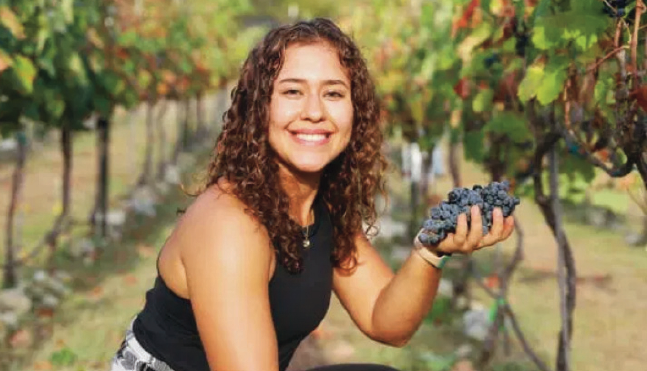S.W. and Rich Hermansen
Guest Writers
wine@lbknews.com
Passing through the portal of Labor Day brings us to an interval neither summer nor  autumn. Nights turn a little cooler as the daylight hours shorten. The afternoon sun often raises temperatures close to summer levels. Cincinnati led into the Labor Day weekend with a high of 94F degrees. The mountains of Montana closed out the last days of summer with an early snow.
autumn. Nights turn a little cooler as the daylight hours shorten. The afternoon sun often raises temperatures close to summer levels. Cincinnati led into the Labor Day weekend with a high of 94F degrees. The mountains of Montana closed out the last days of summer with an early snow.
Grapes in vineyards bask in sunlight leading up to harvest. Winemakers keep a close eye on sugar levels (brix) in wine grapes. Charting of increases in brix as the grapes ripen serves as a prelude to harvest. As brix numbers increase to approach target levels, winemakers begin a countdown to the start of the harvest.
The web even has an app that calculates an alcohol by volume estimate corresponding to a brix measurement or average of brix measurements and a conversion factor. The factor differs by grape variety, region, winemaker preferences, and other details. The conversion factor usually has a value around 0.6, so the app will show the value of 15 (% alcohol) for a brix of 25 and a conversion factor of 0.6.
Brix measurements continue after harvesting and crushing grapes as the grape juice, grape skins, stems, and seeds (must) ferments and reduces the brix of the must as sugars convert to alcohol. As fermentation reduces the brix, the winemaker watches for a target brix and estimated alcohol percentage. In the ideal case for a bone dry wine, the estimated alcohol percentage will approach the winemaker’s target and fermentation will have converted all available sugars to alcohol, leaving no residual sugar in the wine. More often a winemaker will stop or enhance the fermentation process to keep the alcohol percentage of the wine at a target level or increase it. One result of stopping or enhancing fermentation will be a percentage of residual sugar in the wine: minimal in dry wines but somewhat sweet to the taste in off-dry wines, and very sweet in wines with low alcohol percentages and dessert wines.
During the prelude to a wine grape harvest, the winemaker already has an initial plan for the upcoming vintage of the wine. The general plan includes projected dates of harvest when the brix measurement reaches the target number, the time that the wine must begins to ferment, and the end of fermentation when the brix-alcohol percentage measures match their targets.
The actual progression from the initial plan for a wine to the release of the vintage may follow many twists and turns. A hot stretch, or rains or smoke from forest fires, to name a few adverse events, may force a winemaker to select a smaller volume of grapes than expected or intervene in the wine production process to maintain volume at the expense of quality. The better winemakers usually choose the former. Some of the more selective vintages turn out to be outstanding with higher prices compensating for smaller volumes.
Better dry wines retain a luscious fruit and berry despite being bone dry and edgy acidic. The 2022 Pierre Sparr Pinot Blanc from the Alsace wine region of France ($21) has an ABV of 12.5% and a light floral taste that stretches into citrus and apricot. It complements light fin and shell fish. The 2022 Val de Loire Vignobles LaCheteau Muscade Sèvre et Maine Sur Lie ($11) has a golden hue that foretells a canonical wine favoring raw oysters. The “Sur Lie” tag means that the wine has rested on the skins and seeds for an extended time during fermentation and has an added dimension of flavor as a result.. The 2017 Worthy Sophia’s Cuvée Cabernet Sauvignon ($40) brings the intense tastes of the classic California red grape aged in mellow oak to a feast of prime beefsteak.
Forget the steak sauce when you have this wine!
When the plan during the prelude to a wine follows the expected course, the the wines of the vintage live up to expectations. Look for these fortunate vintages and enjoy them.
S.W. Hermansen has used his expertise in econometrics, data science and epidemiology to help develop research databases for the Pentagon, the National Institutes of Health, the Department of Agriculture, and Health Resources and Services. He has visited premier vineyards and taste wines from major appellations in California, Oregon, New York State, and internationally from Tuscany and the Piedmont in Italy, the Ribera del Duero in Spain, the Barossa Valley and McLaren Vale in Australia, and the Otego Valley in New Zealand. Currently he splits time between residences in Chevy Chase, Maryland and St. Armand’s Circle in Florida.
Rich Hermansen selected has first wine list for a restaurant shortly after graduating from college with a degree in Mathematics. He has extensive service and management experience in the food and wine industry. Family and friends rate him as their favorite chef, bartender, and wine steward. He lives in Severna Park, Maryland.

